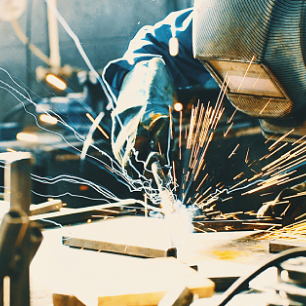Jump to:
Wire Arc Additive Manufacturing: The Promise and the Postprocessing Reality
In the evolving landscape of advanced manufacturing, gas metal arc directed energy deposition (GMA-DED) (https://thermalprocessing.com/advantages-of-wire-arc-additive-manufacturing/) has emerged as a compelling solution for producing large-scale metal components with reduced lead times and material waste. As manufacturers, we are drawn to GMA-DED’s ability to bypass traditional casting or forging bottlenecks, especially when dealing with long procurement cycles or supply chain disruptions. However, while GMA-DED offers a fast track to near-net-shape parts, the journey doesn’t end at the final deposition layer. In fact, that’s where some of the most critical challenges begin.
The Appeal of GMA-DED
The promise of GMA-DED lies in its simplicity, scalability, and basis in traditional arc welding. Using an electric arc as a heat source and wire as feedstock, GMA-DED can build up large metal structures layer by layer with impressive deposition rates and without complex tooling. This makes it particularly attractive for aerospace, maritime, and energy industries, where large, complex parts are often needed at low volumes. However, the feasibility of GMA-DED as a manufacturing solution cannot be evaluated solely by its ability to produce material quickly. Postprocessing, notably machining and nondestructive examination (NDE), must be considered from the outset.
Postprocessing Realities and the Need for NDE
One of the most overlooked aspects of GMA-DED is how its output integrates with traditional downstream processes; additive is not unique in this regard. Unlike parts produced through conventional subtractive methods, GMA-DED components often exhibit unique surface finishes, residual stresses, and microstructural characteristics that complicate postprocessing. For instance, the as-printed surface roughness of GMA-DED parts typically requires extensive machining to meet dimensional tolerances and surface quality requirements. This can negate some of the time and cost savings gained during the additive phase.
Moreover, GMA-DED’s layer-by-layer deposition can introduce internal defects, such as porosity, incomplete fusion, or microcracks. These potential defects are like those found in joining and pose the same problem by not always being visible to the naked eye. This makes NDE a quality assurance step and a critical part of the manufacturing process. However, traditional NDE methods like ultrasonic testing or radiography may not be directly applicable without adjustments. The potential anisotropic nature of GMA-DED parts, combined with their complex geometries, often necessitates customized inspection protocols, which can delay production timelines and increase costs — a short-term problem until techniques and protocols are standardized. Additionally, new manufacturing processes often require more extensive inspection, both in scope and acceptance criteria, than what is typically performed for forged or cast materials.
Moving toward a Holistic Manufacturing Approach
From a manufacturer’s perspective, this disconnect between additive and postprocessing workflows can hinder adoption. We’ve seen cases where GMA-DED parts were printed in record time, only to sit idle for weeks awaiting specialized machining setups or NDE approvals. This bottleneck challenges the speed advantage GMA-DED is supposed to offer.
To truly harness the potential of GMA-DED, we must adopt a more holistic production approach to account for postprocessing steps within design and production planning. This means involving machining and inspection teams early in the development process, ensuring that the part geometry, orientation, and material selection are optimized for printing and everything that follows.
Additionally, standards (https://www.aws.org/about/get-involved/committees/d20-committee-on-additive-manufacturing/) and best practices for GMA-DED-specific postprocessing need to be developed and widely adopted. Industry collaboration between original equipment manufacturers, machine builders, material scientists, and inspection experts is essential to create a framework that supports repeatable, certifiable production.
GMA-DED is not a silver bullet but a powerful tool in the modern manufacturing arsenal. As manufacturers, we must resist the temptation to view additive manufacturing as a standalone solution. Instead, we should evaluate it as part of an integrated production ecosystem, where postprocessing is not an afterthought but a core consideration. Only then can we unlock the full value of GMA-DED and deliver on its promise of faster, smarter, and more flexible manufacturing.
This article was written by Brad Barnhart (engineering manager at The Lincoln Electric Co., Cleveland, Ohio) for the American Welding Society.


